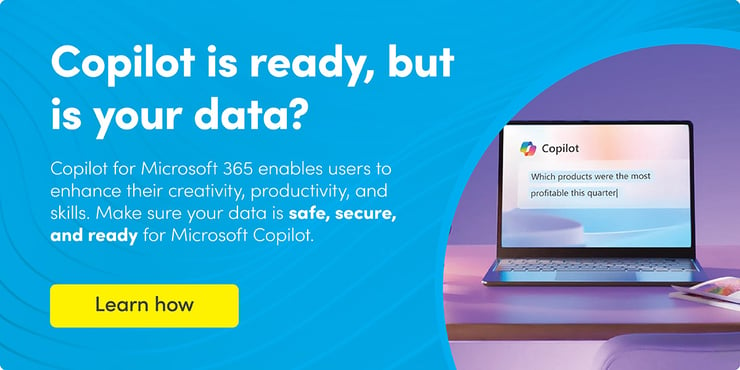Steps Every IT Leader Must Take to Prepare Their Organization for AI
Artificial Intelligence (AI) is undeniably the buzzword of the day, with promises of efficiency, innovation, and competitive advantage. However, integrating AI into their operations can seem daunting for many organizations. Is preparing your organization for AI as intimidating as it sounds? Not necessarily. This article will explore this question and provide actionable tips for IT leaders to secure and prepare their environments for AI implementation.
I began helping organizations prepare for another undeniable change almost ten years ago as the IT industry shifted to "the cloud." Organizations had many of the same concerns with this transition as they do with the move to integrating AI: data integrity, security, ROI, change management, etc. The best way to prepare for these changes is to begin by assessing your IT environment today. Do you have a handle on data governance and security going into this transition? Those organizations that can answer yes to this question with confidence will be ahead of their competitors.
Overcoming Daunting Challenges
- Understanding the Challenge: Before diving into the steps to prepare for AI, it's essential to understand why the process can appear daunting. You’re not alone and this is expected.
- Complexity: AI involves intricate algorithms and technologies, making it appear complex and challenging to grasp.
- Data Dependencies: AI systems heavily rely on quality data, and collecting, organizing, and maintaining this data can be challenging.
- Data Security: Sensitive data needs to be protected within AI solutions, and employees require education about the importance of security.
- Cultural Shift: Embracing AI often requires a cultural shift within an organization, which can be met with resistance from employees.
- Cost: Implementing AI can be expensive, and the ROI may take time to be apparent.
Regulatory Concerns: Organizations must navigate legal and ethical considerations when handling sensitive data and making automated decisions.
8 Steps to Get Started with AI Preparation
Now that we've acknowledged the challenges let's discuss how to get started with preparing your organization for AI in a manageable way:
- Define Clear Objectives: Identify specific AI use cases that align with your organization's goals. What problems do you want AI to solve, and what outcomes are you aiming for?
- Create an AI Steering Committee: Assemble a cross-functional team to help set the direction and prioritize initiatives around AI and your business. Collaboration is key.
- Data Strategy: Develop a robust data strategy, including data collection, storage, quality assurance, and privacy considerations. Clean, structured data is the foundation of successful AI implementations.
- Security: Evaluate your current security program to ensure that it can adapt to a modern environment that will protect your people and data.
- Start Small: Begin with a pilot project or a proof-of-concept to gain experience and demonstrate value. It's easier to manage and learn from small-scale initiatives.
- Cloud-Based Services: Leverage cloud-based AI services provided by major cloud providers. They offer pre-built AI models and infrastructure, reducing the technical burden.
- Ethical Framework: Establish an ethical framework for AI usage, including transparency, fairness, and accountability. Ensure compliance with regulations like GDPR or HIPAA.
- Training and Education: Invest in training and educating your workforce about AI's benefits and how it fits into your organization's future.
Action Items for IT Leaders
IT leaders play a crucial role in shaping the AI preparedness of their organizations. Here are some action items they should consider:
- Conduct an Assessment: Assess your current data governance and security programs to help prepare your environment for AI solutions.
- Create an AI Roadmap: Develop a clear roadmap for AI integration, outlining milestones, timelines, and resource allocation.
- Allocate Resources: Ensure the availability of necessary resources in terms of budget and skilled personnel.
- Monitor Industry Trends: To make informed decisions, stay updated on AI trends, technologies, and best practices. Continuously monitor and measure the ROI of AI projects to justify investments and adjust when necessary.
Preparing your organization for AI can be more manageable than it sounds. By taking a strategic approach, defining clear objectives, and following the steps outlined, you can pave the way for a successful AI integration that drives innovation and competitiveness while addressing the associated challenges. Embrace AI as an opportunity for growth, and with the right approach, your organization can unlock its full potential in the age of artificial intelligence.
Harness the power of artificial intelligence (AI) in your organization with Microsoft 365 Copilot. If your organization wants to improve productivity by using Microsoft Copilot, Synergy Technical can help. Our Microsoft 365 Copilot Readiness Assessment will validate your organization's readiness for Copilot as well as provide recommendations for configuration changes prior to implementation. We'll help you make sure that your data is safe, secure, and ready for your Copilot deployment.






Comments